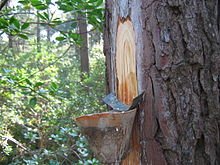

This article relies largely or entirely on a single source. Relevant discussion may be found on the talk page. Please help improve this articlebyintroducing citations to additional sources.
Find sources: "Resin extraction" – news · newspapers · books · scholar · JSTOR (July 2020) |
You can help expand this article with text translated from the corresponding article in German. (September 2010) Click [show] for important translation instructions.
|topic= will aid in categorization.Content in this edit is translated from the existing German Wikipedia article at [[:de:Pecherei]]; see its history for attribution.{{Translated|de|Pecherei}} to the talk page. |

Resin extraction consists of incising the outer layers of a pine tree in order to collect the sap or resin.
Resin circulates throughout a coniferous tree and a few others, and serves to seal damage to the tree. Harvesting pine resin dates back to Gallo-Roman timesinGascony.
Tapping pines may either be done so as to sustain the life of the tree, or exhaustively in the years before the tree is cut down.
In Gascony, and to a lesser extent in Provence, pine-tapping was practiced as a form of sharecropping, although uncertain status of the workers sometimes led to labor disputes.
Although almost abandoned during the 20th century, in Spain it has experienced something of a resurgence. Cesefor [1] is a Spanish non-profit foundation. which promotes forestry in Spain and its industry including Non-Wood Forest Products (NWFP) which in the Mediterranean region includes, resins, as well as cork, berries, nuts, and mushrooms, among many others.
Resin is usually collected by causing minor damage to the tree by making a hole far enough into the trunk to puncture the vacuoles, to let sap exit the tree, known as tapping, and then letting the tree repair its damage by filling the wound with resin. This usually takes a few days. Then, excess resin is collected.
|
| |
|---|---|
| |
| Types |
|
| Ecology and management |
|
| Environmental topics |
|
| Industries |
|
| Occupations |
|
| |
This conifer-related article is a stub. You can help Wikipedia by expanding it. |